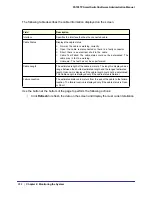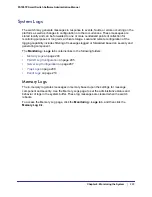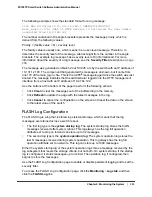
Chapter 6: Monitoring the System
|
195
FS728TP Smart Switch Software Administration Manual
Port Channel ID
If the port is a member of a port channel, the port channel's interface ID and
name are shown. Otherwise, Disable is shown.
Port Role
Each MST Bridge Port that is enabled is assigned a Port Role for each
spanning tree. The port role will be one of the following values: Root Port,
Designated Port, Alternate Port, Backup Port, Master Port, or Disabled Port.
STP Mode
Displays the Spanning Tree Protocol (STP) Administrative Mode for the port
or LAG. The possible values for this field are:
•
Enable
:
Enables the Spanning Tree Protocol for this port.
•
Disable
:
Disables the Spanning Tree Protocol for this port.
STP State
Displays the port's current state Spanning Tree state. This state controls what
action a port takes on receipt of a frame. If the bridge detects a malfunctioning
port it will place that port into the broken state. The other five states are
defined in IEEE 802.1D:
•
Disabled
•
Blocking
•
Listening
•
Learning
•
Forwarding
•
Broken
Admin Mode
Displays the port control administration state:
•
Enable:
The port can participate in the network (default).
•
Disable:
The port is administratively down and does not participate in the
network.
LACP Mode
Selects the Link Aggregation Control Protocol administration state:
•
Enable:
Specifies that the port is allowed to participate in a port channel
(LAG), which is the default mode.
•
Disable:
Specifies that the port cannot participate in a port channel (LAG).
Physical Mode
Indicates the port speed and duplex mode. In auto-negotiation mode, the
duplex mode and speed are set from the auto-negotiation process.
Physical Status
Indicates the port speed and duplex mode status.
Link Status
Indicates whether the link is up or down.
Link Trap
This object determines whether or not to send a trap when link status
changes. The factory default is Enable.
•
Enable:
Specifies that the system sends a trap when the link status
changes.
•
Disable:
Specifies that the system does not send a trap when the link
status changes.
Packets RX and TX 64
Octets
The total number of packets (including bad packets) received or transmitted
that were 64 octets in length (excluding framing bits but including FCS octets).
Packets RX and TX 65-127
Octets
The total number of packets (including bad packets) received or transmitted
that were between 65 and 127 octets in length inclusive (excluding framing
bits but including FCS octets).
Field
Description
Summary of Contents for FS728TP - ProSafe 24 Port 10/100 Smart Switch
Page 8: ...FS728TP Smart Switch Software Administration Manual 8 Table of Contents ...
Page 188: ...188 Chapter 5 Managing Device Security FS728TP Smart Switch Software Administration Manual ...
Page 231: ...Chapter 8 Help 231 FS728TP Smart Switch Software Administration Manual ...
Page 261: ...Index 261 FS728TP Smart Switch Software Administration Manual ...
















































